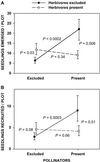Interaction of pollinators and herbivores on plant fitness suggests a pathway for correlated evolution of mutualism- and antagonism-related traits
- PMID: 12482948
- PMCID: PMC139228
- DOI: 10.1073/pnas.252362799
Interaction of pollinators and herbivores on plant fitness suggests a pathway for correlated evolution of mutualism- and antagonism-related traits
Abstract
Different kinds of plant-animal interactions are ordinarily studied in isolation, yet considering the combined fitness effects of mutualistic and antagonistic interactions is essential to understanding plant character evolution. Functional, structural, or phylogenetic associations between attractive and defensive traits may be nonadaptive or result from correlational selection on sets of herbivory- and pollination-linked traits. Nonadditivity of fitness effects of mutualists and antagonists, a requisite for correlational selection, was experimentally tested in the field. We created experimental populations of the insect-pollinated perennial herb, Helleborus foetidus, at 16 different locations distributed among three regions in the Iberian Peninsula. Plants experienced one of four possible selective regimes generated by independently weakening the effects of pollinators and herbivores (flower and fruit predators) according to a two-way fully factorial design. Effects were assessed in terms of number of next-generation offspring recruited per mother plant under natural field conditions. Differences among H. foetidus plants in the strength of their interactions with pollinators and herbivores translated into differential fitness, as measured in terms of recruited offspring, and subsequent changes in plant population densities. A strong, geographically consistent nonadditivity in the fitness consequences of pollinators and herbivores was found also. Plants possessing the particular combination of "traits" simultaneously enhancing pollination and escape from herbivores enjoyed a disproportionate fitness advantage over plants possessing any of the other three possible "trait" combinations. Results suggest a simple, possibly widespread ecological pathway favoring the adaptive correlated evolution of mutualism- and antagonism-related plant traits in pollinator-dependent plants suffering intense flower and fruit herbivory.
Figures



References
-
- Schemske D. W. & Horvitz, C. C. (1988) Ecology 69, 1128-1137.
-
- Herrera C. M. (1989) Oikos 54, 185-188.
-
- Herrera C. M. (2000) Ecology 81, 2170-2176.
-
- Cunningham S. A. (1995) Am. J. Bot. 82, 1527-1536.
-
- Galen C. (1999) Oikos 85, 426-434.
LinkOut - more resources
Full Text Sources

